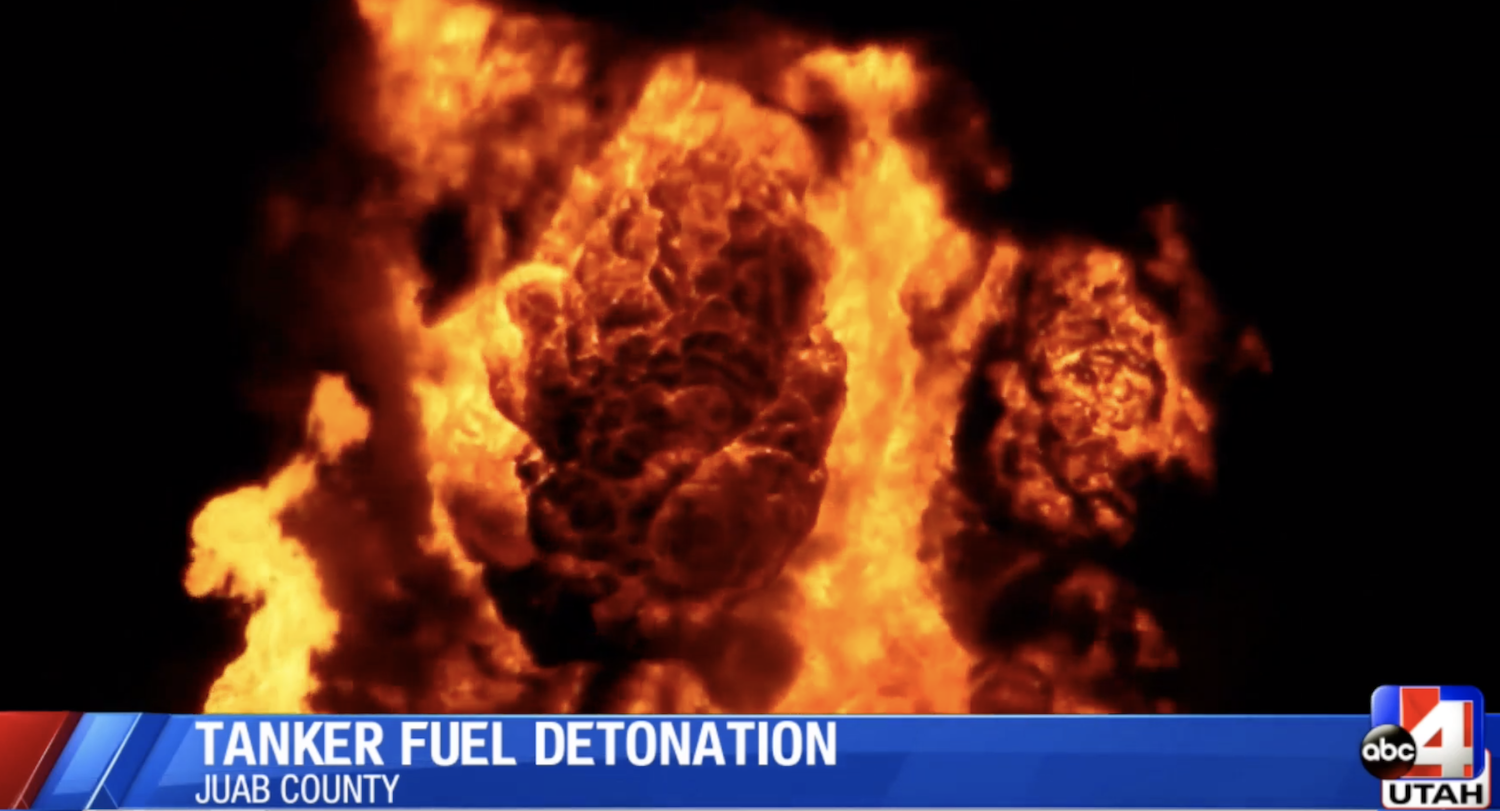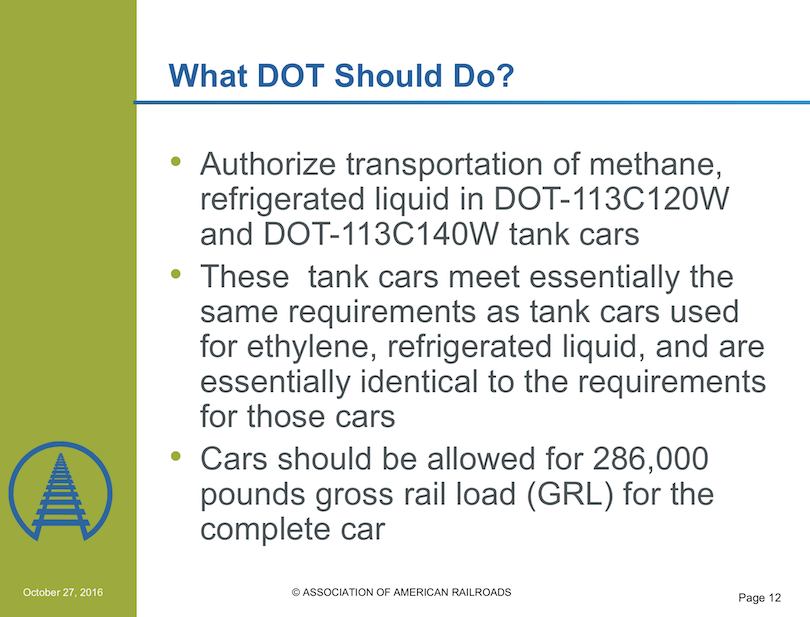On April 10, first responders in Durham, North Carolina, responded to a suspected natural gas leak. While they were evacuating people from the area, the gas exploded, killing one person and injuring at least 25.
The same day Durham was dealing with the aftermath of a deadly natural gas explosion, President Donald Trump was issuing an executive order directing federal regulators to create new rules allowing rail companies to transport liquefied natural gas (LNG) by train in the next 13 months, or less.
The gas and rail industries have lobbied for years to allow LNG by rail, and have found a willing partner in the Trump administration. Last week’s executive order was cheered by lobbyists for both natural gas and rail. One lobbyist, Charlie Riedl of the Center for Liquefied Natural Gas, immediately spoke about the purported safety of moving natural gas in any form.
“It’s really hard to even get it to ignite to begin with in a gaseous format, let alone in a liquid format,” Riedl told Bloomberg.
Durham, however, might disagree.
I climbed to the top of our parking garage to get this footage of a reported gas leak in Durham @WRAL pic.twitter.com/0whWsfU4s1
— Christian Leonard (@ChristianLnrd) April 10, 2019
Are Federal Regulators Testing the Safety?
As I wrote in January 2017, Robert Fronczak, a top official at the Association of American Railroads (AAR), a railroad industry lobbying group, gave the industry position on LNG by rail in a late 2016 presentation titled, “Getting LNG Onto the Rails.”
At the Energy by Rail conference, Fronczak noted that the Department of Transportation’s Federal Railroad Administration (FRA) was researching the risks of transporting LNG by rail, but that according to Fronczak, “That could take several years to do and we don’t think it’s necessary to wait all that long … We think they should allow it immediately.”
Fronczak’s presentation also included a slide titled, “What DOT Should Do?” (DOT refers to the Department of Transportation.) His presentation recommended transporting LNG in a class of refrigerated tank cars called DOT-113, which is used to move the hydrocarbon ethylene.
From Getting LNG Onto the Rails presentation October 27, 2016. Credit: Robert Fronczak, AAR
In 2017, DeSmog asked the Federal Railroad Administration about the planned testing around LNG by rail, but the response provided few details: “The testing is still ongoing … there’s no prediction yet on a completion date.”
Last week DeSmog inquired again about the status of this research and received a similar response: “Additional tests are planned this year and next but full details are not yet available.”
These answers are typical of the communication from the FRA these days.
In a follow-up email I asked one question, “Simply put, how can we assure people that this is safe when the research hasn’t been done?”
The FRA‘s emailed response did not answer the question directly but, just as in Fronczak’s presentation, referenced the refrigerated tank cars used to transport ethylene: ”DOT-113 cryogenic tank cars have been in service for approximately 50 years transporting ethylene, refrigerated liquid (ethylene and methane have the same cryogenic and flammable characteristics) with a good safety record.” (Natural gas is primarily methane.)
The president has mandated that regulations allowing LNG by rail be in place in 13 months. However, the FRA currently isn’t providing any public information on actions the agency is taking to ensure this can be done safely. And while it is true that the DOT-113 tank cars have been moving hazardous materials safely for years, the number of these tanks cars in service is quite low compared to crude oil and ethanol. In 2015 there were under 13,000 car loads of product moved using DOT-113 tank cars.
To put that in perspective, according to a 2014 AAR document, U.S. railroads were transporting 9,500 carloads of crude oil in 2008 but by 2013, that number skyrocketed to 407,761 carloads. Crude oil trains weren’t experiencing major derailments before rail companies shifted to transporting oil in long unit trains of 100 cars or more at high volumes, which was the case in 2013, the year of the deadly Lac-Mégantic crude oil derailment.
The problems with moving oil by rail showed up once large amounts of crude oil began moving in these long trains dedicated to just moving crude oil (unit trains). As I’ve noted on DeSmog, the oil-by-rail boom also coincided with the use of heavier rail cars that could hold up to 286,000 pounds when fully loaded. The DOT-113 tank cars likely to carry LNG can hold the same weight.
In pushing for LNG by rail, Fronczak was just doing his job, which is to promote rail industry interests, that is, profits. That is what lobbyists are paid to do.
When contacted for comment, the AAR pointed to its recent press release on Trump’s executive order and the AAR‘s petition to allow LNG by rail. The rail lobbying group did not address questions about the AAR‘s current position on unit trains and train length regulations for LNG.
However, unlike the AAR, the FRA‘s job is to regulate the rail industry and protect the public from unnecessary risks.
Misleading Media Headlines
A headline on a story from the oil and gas trade site Oilprice.com, which also appeared on Yahoo Finance, dismisses concerns about the dangers of LNG by rail: “Environmentalists’ “Bomb Train” Concerns Are Overblown.” (“Bomb train” is the nickname rail operators gave oil trains after they began exploding with giant fireballs after derailing.)
While the headline is dismissive, the story itself includes information contradicting the headline and spelling out the very real safety concerns regarding LNG by rail. It mentions “plenty of cautionary tales from previous experiments in sending oil and gas by rail, from spills, explosions, and accidents” to the oil train disaster that killed 47 in Lac-Mégantic, Quebec, in 2013.
Despite its headline and after citing industry views on the relative safety of LNG, the story goes on to say, “While that sounds like any cause for alarm and cries of ‘bomb trains’ is overblown, however, there is still a wide margin for risk if a tank of LNG were ruptured or caused in any other way to come into contact with air.”
Utah’s Propane Bomb Train Previews LNG by Rail
An important detail in this conversation about moving LNG by rail is that the LNG likely would travel in much more robust, safer tank cars, the DOT-113 line, than even the new cars used to move ethanol and oil. Even though rail companies now are transporting oil in newer tank cars, those cars have failed repeatedly during derailments, resulting in large oil spills.
Liquefied propane currently travels in DOT-112 tank cars, which are also more robust than the ones used for oil and ethanol. At the end of March, a train moving propane in Utah derailed and the damage led to some propane leaking. However, the derailment was nothing like the typical oil train derailment, with multiple ruptured cars and major product releases.
Why aren’t oil and ethanol moved in the same tank cars as propane? This idea was floated at one point as the Department of Transportation was preparing its 2015 oil-by-rail regulations, but industry lobbyists quickly vetoed it. As a result, the tank cars that oil and ethanol travel in remain one of the many risk factors surrounding these products’ transport.
The accident in Utah showed that the tank cars used to move propane do a better job at preventing product releases than the ones used to move crude oil. However, it also highlights the risks of moving these flammable materials by rail.
While the train in Utah didn’t explode on its own after derailing, the damage to the rail cars carrying the propane and its explosion risks led responders to decide the best way to deal with the derailed cars was to detonate them in place.
Video of propane tank car detonation in Juab County, Utah. Credit: Juab County Sheriff’s Office
This was possible because it was in rural Utah, more than 70 miles from Salt Lake City and six miles outside a town of less than 700. However, the natural gas and rail industries’ top priority for introducing LNG by rail is to move LNG to the Northeast, which is experiencing pipeline bottlenecks.
That means trains carrying LNG would go by and through major cities.
Can you safely detonate rail cars full of flammable gas in a major population center?
As the U.S. grapples with a potential boom in moving fracked natural gas-turned-LNG across this country using long, heavy unit trains, it seems like a question the FRA should be examining. As I’ve documented over the years, we know what happened when federal regulators failed to do this before the crude-by-rail boom: We discovered “bomb trains.”
Main image: Screen shot of detonation of propane rail cars in Juab County, Utah. Credit: ABC 4 Utah
Subscribe to our newsletter
Stay up to date with DeSmog news and alerts








